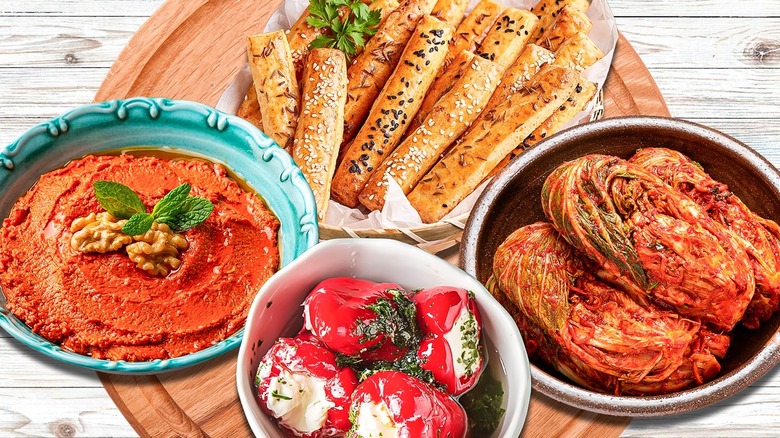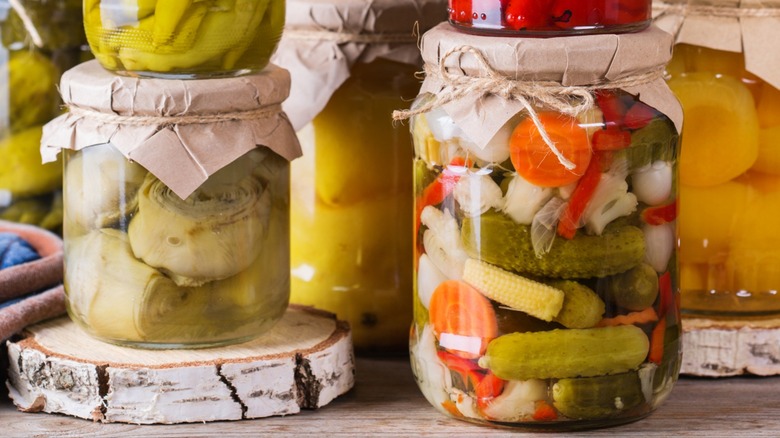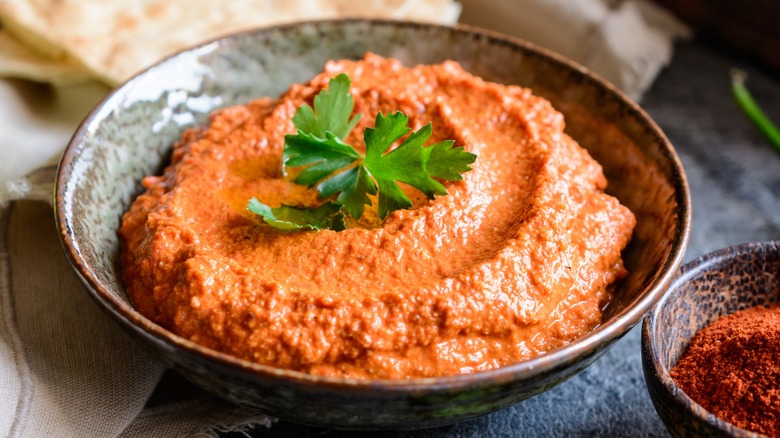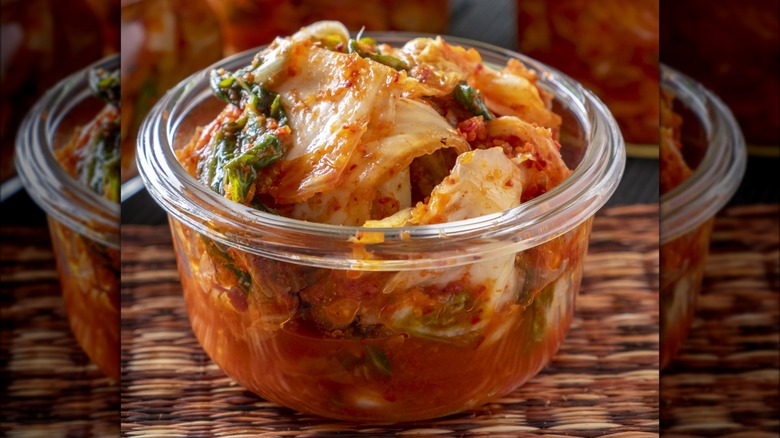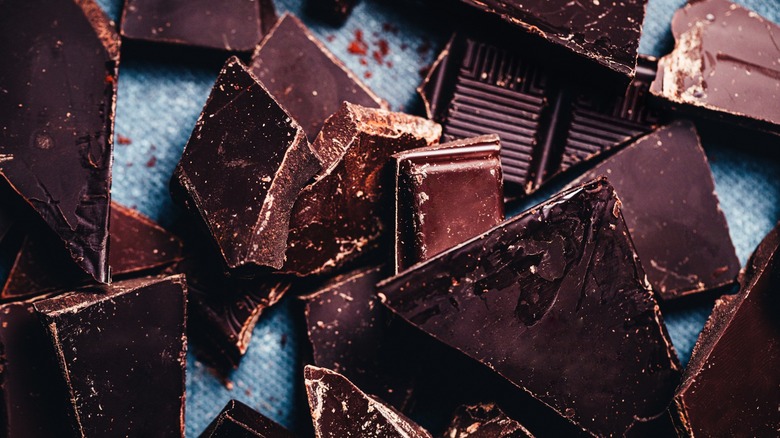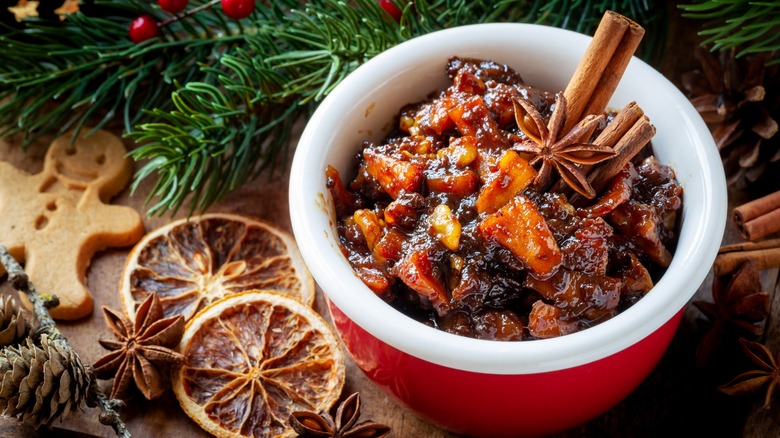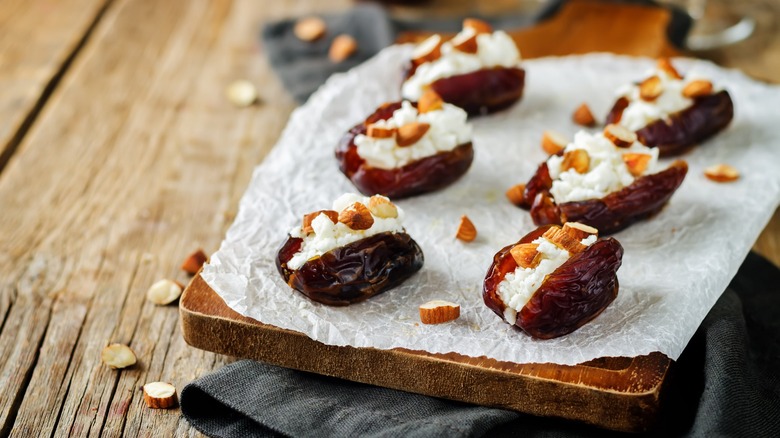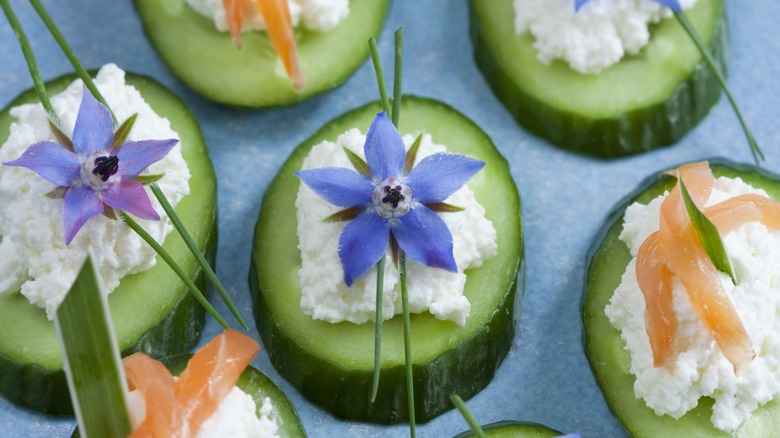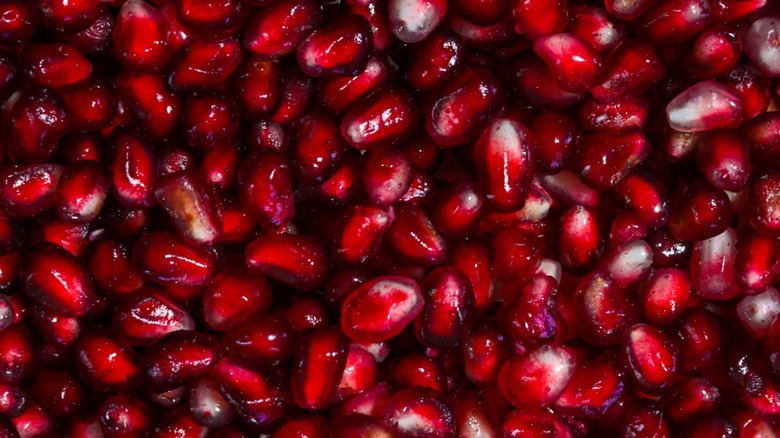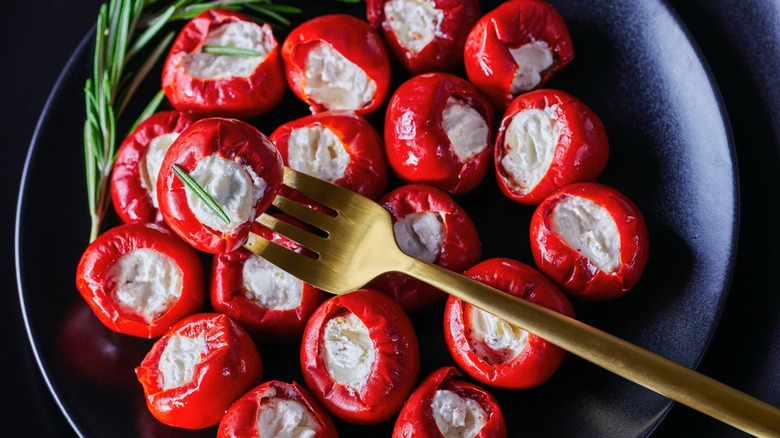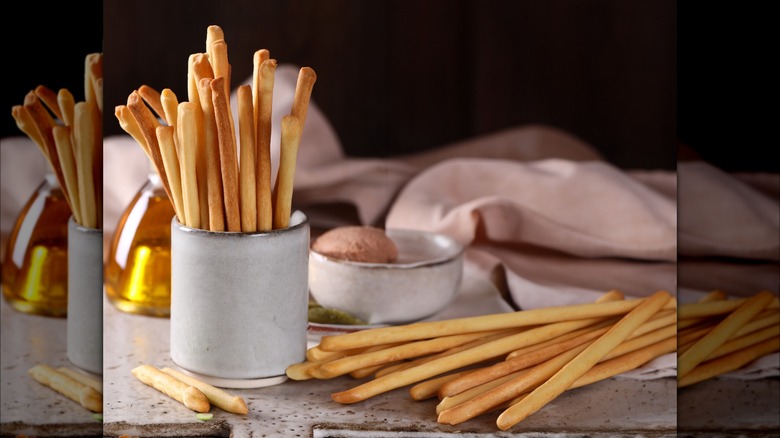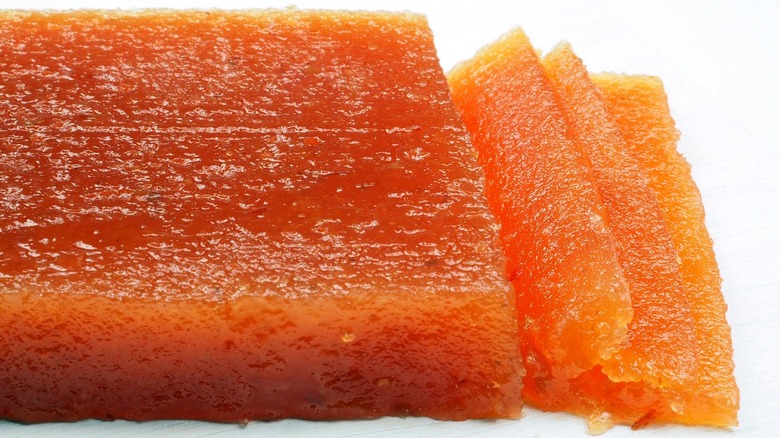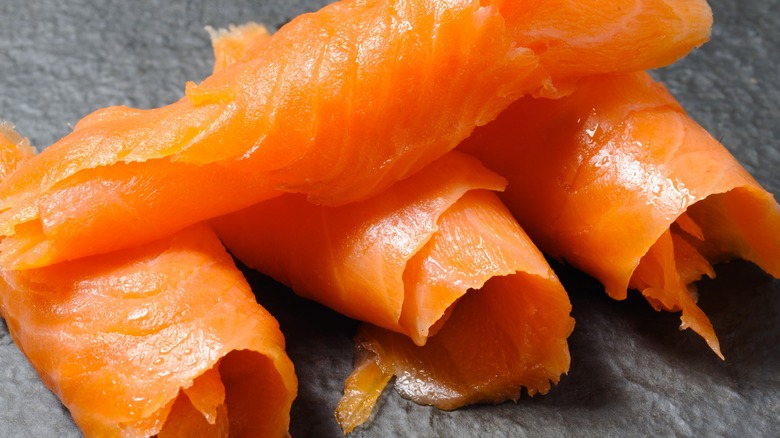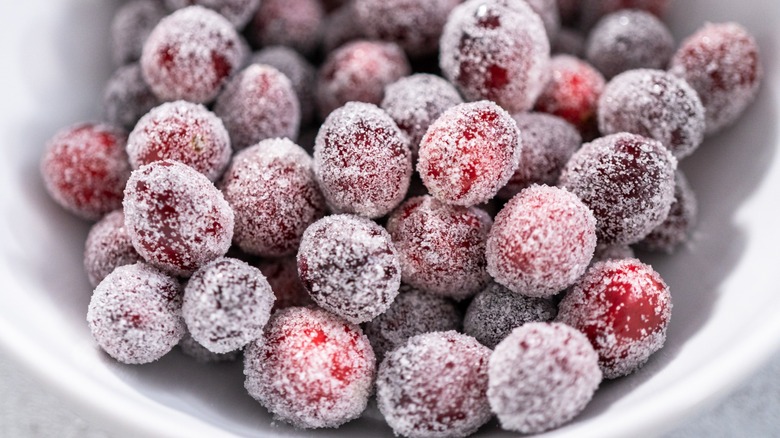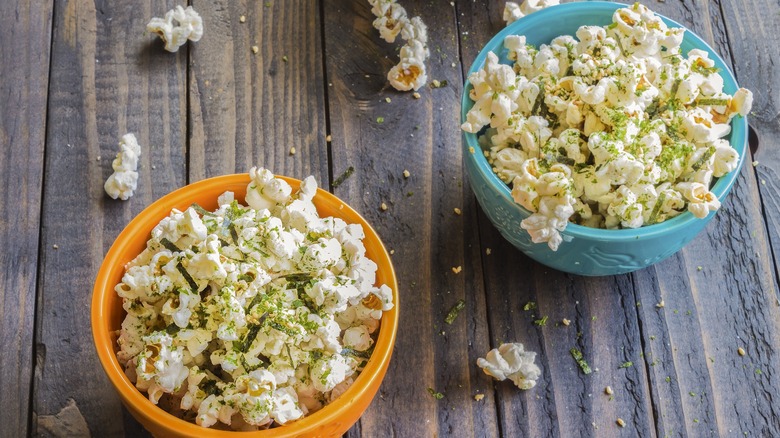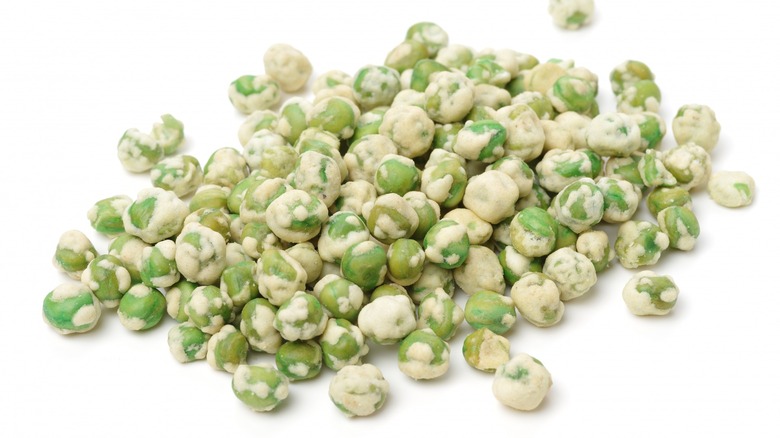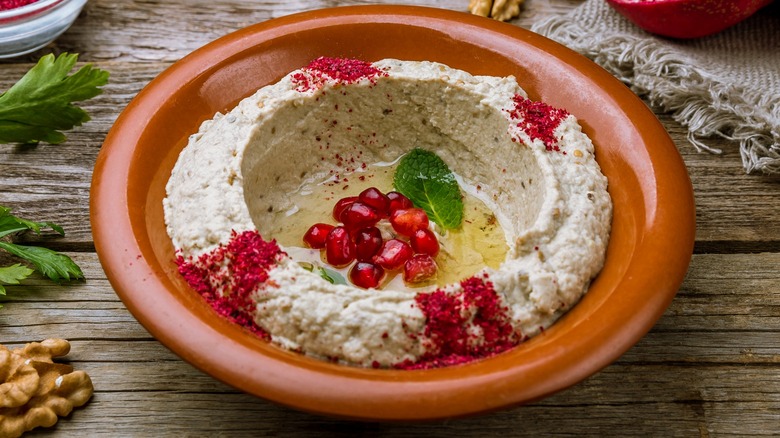16 Underrated Foods To Include On Your Next Charcuterie Board
If you are going to build a charcuterie board, you probably already know that cured meats are traditionally the most important components. Nowadays, charcuterie boards have expanded to include all sorts of inventive and aesthetically pleasing ingredients. When creating a balanced spread, it's important to consider foods with varied textures and complementary flavors and colors. And, of course, making your charcuterie board Instagrammable is a crucial element to many in today's world, so honing your artistic arranging skills is also a must.
Beyond meats and cheeses, charcuterie boards should include several other snackable accompaniments. It should require little to no cooking, so think outside the box by looking for unexpected dips, condiments, dried foods, and fermented and pickled additions. Including a few impressive ingredients that your guests may have never thought to include before will make your board stand out from the others. Let's look at some underrated foods to include on your next charcuterie board.
Pickles (other than cucumbers)
When you think of pickles, you probably think of cucumbers. However, there are other types of pickled vegetables you might want to consider keeping on hand — and including in your next charcuterie board. To spruce up your selection and surprise your guests, pickle some outside-the-box fruits and vegetables yourself or check out the selection of your local specialty gourmet foods or import stores. Some easy-to-find options include radishes, beets, carrots, and cauliflower. To spice things up, opt for pickled jalapeños, or to add a little tangy sweetness, consider pickled strawberries, which pair beautifully with goat cheese.
There's also the option of including pickled vegetable medleys like spicy Chicago-style giardiniera, which can be homemade or store-bought. The British spread Branston is another unexpected way to add a pickled, umami flavor to pair with meats and cheeses. Traditionally, Branston is used in ploughman sandwiches and cheese and pickle sandwiches in the United Kingdom; this pickled vegetable spread pairs wonderfully with aged white cheddar.
Muhammara
What's a good charcuterie board without spreads and dips? While hummus is typically the go-to dip to include, muhammara is another Middle Eastern dip that makes a great option. Not only will it introduce your guests to a unique flavor they may never have experienced, but its red hue can add a much-needed splash of color, making your board all the more aesthetically pleasing.
Composed of roasted red bell peppers, Aleppo peppers, walnuts, and pomegranate molasses, Muhammara is a classic dip in Middle Eastern mezze spreads. The nutty and sweet notes of the walnuts and pomegranate make it an effortless pairing with many meats and cheeses, and the complex spiciness of the Aleppo peppers gives it a surprise kick. You can easily follow our Muhammara recipe to make the dip from scratch or find it pre-made at the store. If opting for store-bought, this delicious spread can be found at markets like Publix and Whole Foods.
Kimchi
Are you looking to add a unique and healthy snack to your next charcuterie board? Look no further than kimchi. One of the shining stars of Korean cuisine, it may initially seem odd to include fermented cabbage on your spread of meats, cheeses, and dips, but adding store-bought kimchi to a board is a quick and easy way to put a spicy spin on your preserved vegetable addition.
There are many types of kimchi, but the jarred options you can find in the international food aisle of your local grocery store usually include a fermented formula of cabbage, green onions, and other vegetables alongside various spices, alliums, and gochugaru (a type of powdered red chili pepper). Its biggest benefit is its powerful probiotic properties. So, not only is it good for your gut, but its flavor is also undeniably delicious. Kimchi's tangy flavor notes could easily replace the sourness that pickles provide with the added surprise of spice.
Dark chocolate
Dark chocolate may be more famous for starring in desserts and sweet treats, but its complex flavor profile and bitterness make it a perfect pairing with numerous cheeses on your charcuterie board. While you may feel tempted to pair a naturally sweeter cheese with chocolate, funky cheeses like Gorgonzola offer a unique contrast. If funk isn't your thing, make a subtler choice by opting for a milder cheese like Brie.
For an extra surprising dark chocolate cheese pairing that will wow the socks off your guests with unexpected flavors, look no further than Parmesan. When eaten one after the other, the chocolate will bring out the nuttiness of the cheese, while the cheese will enhance the rich coffee-like bitterness of the chocolate. Plus, the saltiness of Parmesan is a no-brainer with chocolate. The next time you're whipping up an Italian snack board that includes Parmesan, try adding a high-quality gourmet Italian dark chocolate; you might be surprised by how perfectly delectable the combination turns out.
Mincemeat
Despite the name, mincemeat doesn't contain any meat. So, what is mincemeat exactly? Once upon a time, it wasn't vegetarian. Nowadays, the mixture found in homemade mincemeat pies and tarts — or store-bought ones, like Walkers — typically are composed of dried fruit, nuts, warm spices, candied citrus, and sometimes liquor like brandy or Port wine.
While the British favorite is usually found in pies around the winter holidays, it can also make a unique sweet spiced spread on meat and cheese boards, especially if you're making an appetizer platter for a festive gathering. To make a homemade version, follow our recipe for an all-fruit mincemeat pie, but skip the pie crust step. To make it, combine the filling ingredients and simmer for at least 40 minutes, then use a food processor to puree until only slightly chunky, and refrigerate for several days.
If you don't have time to make it from scratch, pre-made, ready-to-use, jarred mincemeat makes adding mincemeat to your charcuterie board more approachable. While more commonly found in the United Kingdom, it's worth checking out international markets and online stores to try to find it.
Stuffed dates
Dates are a wonderfully versatile dried fruit that we think you should always have in your kitchen. The sweet fruit of the date palm boasts a wide range of culinary uses, from sweetening smoothies to starring in appetizers like bacon-wrapped dates. While dates can certainly go solo on a charcuterie board, we suggest jazzing them up a bit by stuffing them. Goat cheese makes a heavenly pairing with dates; slicing the dates open, removing the pits, and filling them with tangy goat cheese is one quick and easy way to elevate this ingredient for your charcuterie board.
If you want to get extra gourmet with your date presentation, follow this recipe for pecan-stuffed dates with balsamic. After slicing and removing the pits, fill the dates with cream cheese, top with a single pecan, sprinkle with fresh rosemary sprigs, and then drizzle with balsamic. They're a great addition to holiday charcuterie boards, where the aesthetically pleasing presentation and combination of sweet and savory flavors will have your guests gathering around the board and coming back for more.
Edible flowers
One way to instantly make your charcuterie board more visually appealing is to sprinkle on some edible flowers. This trick comes in handy when your meats, cheeses, and dips are lacking in vibrant colors. Borage flowers will add a beautiful blueish-purple color that would be hard to achieve otherwise; many note they taste like cucumbers, making them a natural pairing for meats and cheeses. However, numerous edible flower options are available, from dainty apple blossoms to hearty, deep red hibiscus flowers. Likewise, sprigs of lavender are easy to find and pair beautifully with cheeses and honey.
Even better, tracking down edible flowers may be easier than you think. With the popularity of edible flowers on the rise, fresh ones are often available in supermarkets like Whole Foods. Not only are such flowers great for adding color, but they can also add an element of romance and storytelling to your charcuterie board. This is because many flowers have symbolic and mythological meanings.
You can't go wrong by adding a bit of the botanical world to your selection, especially when making charcuterie boards for spring and summer gatherings. Or, for a fun Valentine's Day-themed platter, include edible dried rose petals.
Pomegranate seeds
Antioxidant-packed pomegranates are an underrated fruit choice to add to your charcuterie board. The seeds are not only pleasantly crunchy and deliciously tart, but the shining red morsels also have a jewel-like appearance capable of bedazzling even the most boring meat and cheese spreads. They are an especially welcome — and even necessary — addition to many Middle Eastern and Mediterranean-themed charcuterie boards.
While removing pomegranate seeds without making a mess can be a tricky task, it's worth the extra effort. Once sliced open, there are a few ways to present these glowing, juicy seeds on your board. Serve them in a bowl with a mini serving spoon and let guests scoop out a desired amount. Alternatively, sprinkle the seeds throughout the board to give it a scattered, jeweled appearance.
If you want to make your charcuterie board look like a Renaissance still-life painting worthy of a museum, allow the seeds to spill out of the shell after splitting a whole pomegranate open. However, if you take this route, try knocking most of the pomegranate seeds loose first for easier access.
Stuffed cherry peppers
If you aren't familiar with cherry peppers, you should be able to find this ingredient at the grocery store in the same aisle as pickles. Due to their tough skin, cherry peppers are typically only eaten pickled, so you'd be hard-pressed to find fresh ones. While similar to pimentos, cherry peppers are slightly spicier — and perfect for making bite-stuffed peppers to give your charcuterie board a pop of color and a burst of zing.
The good news is making stuffed cherry peppers is super easy for all levels of home cooks. After you have acquired a store-bought jar of cherry peppers, start by draining the liquid. There are many options for stuffing, but we suggest making a simple filling by combining cream cheese, ricotta cheese, garlic powder, and chopped parsley. Neatly spoon the cheese filling into the peppers and serve them alongside your favorite Italian cured meats, aged cheeses, and gourmet olives for a classic charcuterie board with a twist.
Grissini
What would a charcuterie board be without a variety of crackers? Crunchy companions are necessary to balance textures, but if you're bored of your typical party crackers and want something slightly outside the box, opt for Italian grissini. These versatile, small, and crispy breadsticks are a fantastic alternative to crackers and a natural pairing with flavorful cheeses, prosciutto, and other Italian cured meats. The long, skinny shapes of the breadsticks also make them easy to wrap pieces of meat around and are an ideal size for dunking into dips.
Of course, you can follow a grissini recipe to make your own — but they're also surprisingly easy to find on grocery shelves. Italian markets like Eataly carry plenty of brands both online and in stores. Alessi is one option and is commonly available in many supermarkets. A gluten-free grissini alternative by Schar is also carried in grocery stores like Publix.
Membrillo
It isn't uncommon for charcuterie boards to include fruity flavors. Figs, pears, and grapes are a few fruits that come to mind; they are usually paired with a wide range of cheeses and meats. For a lesser-known — but as scrumptious — fruit option, we think you should consider the quince. Quinces are similar to apples and pears yet have a distinctively tart flavor. However, they are rarely eaten raw due to their sourness and tough texture.
One delicious way to add this unexpected fruit to your charcuterie board is through quince paste, also called membrillo or quince cheese. It's enjoyed in several cultures around the world, including Spain, where it's often seen paired with manchego. Thus, quince paste is a must if opting for a Spanish-themed charcuterie board.
If you find fresh quinces at your local markets, you could follow a membrillo recipe and make your own. However, the simpler alternative is to buy it pre-made at the grocery store. While not every market carries it, look for this ingredient near the gourmet cheese section. However, if none of your local grocery stores or specialty shops stock this item, purchasing online is always an option.
Smoked salmon
What do prosciutto, soppressata, mortadella, and capicola all have in common? Not only are they all popular cured meats to place on charcuterie boards, but they are also all made from pork. For those who avoid pork, are pescatarians, or generally prefer seafood, "seacuterie" boards using tinned fish like tuna, sardines, and mussels are becoming more popular. However, smoked salmon and lox are arguably the closest things to more traditional charcuterie meats, given how the fish is cured and preserved.
While smoked salmon may be more associated with breakfast and bagels, there are plenty of fun ways to include it on your next charcuterie board. When doing so, tweak the other ingredients on the board. For example, jams and cheeses that pair wonderfully with meats like prosciutto may not complement smoked salmon's flavor. Thus, creating a themed board with other snacks commonly eaten with smoked salmon is essential.
Consider pairing this ingredient with a spread of pickles, olives, and capers, and opt for softer cheeses like Brie and cream cheese. Instead of your usual crackers, try a riff on smoked salmon and bagels by choosing something like Trader Joe's Everything but the Bagel crackers.
Sparkling cranberries
It's important to include at least one ingredient on your charcuterie board that will expose your guests to the sweeter side of life. Most will opt for the natural sweetness of fruits or jams. However, if you're making a charcuterie board for the holidays, consider adding sparkling cranberries to enhance flavor and aesthetics. These sugar-coated cranberries provide an extra sweet and tart way to add a decorative element to your platter.
Sparkling cranberries pair wonderfully with Brie, as in these sparkling cranberry Brie bites. That said, you don't necessarily have to make this fancy canapé to include them alongside your charcuterie mix. Instead, follow the recipe and make the cranberries alone by soaking them in warm simple syrup and coating them in sugar. This results in cranberries that look dusted with glistening snow. Once ready, sprinkle them throughout your board; add a few rosemary sprigs alongside the berries for a more festive look.
Flavored popcorn
Popcorn is one of the most beloved snack foods, so what's stopping you from giving it a spot on your next charcuterie board? You may associate this snack with movie nights, but when elevated with gourmet seasonings, popcorn can compete with the other flavors on your board. Flavored popcorn is especially delicious with aged cheeses and tangy pickles.
With so many popcorn seasonings on the market, the sky's the limit. Popcorn can be tweaked to match the flavors of almost any themed board. Are you going for a "seacuterie" board? Try nori popcorn for an umami seaweed accompaniment. Does your charcuterie board lean toward Middle Eastern flavors? Include popcorn flavored with za'atar.
Spicy citrus popcorn is a versatile gourmet treat that would pair nicely with a variety of flavors. For an extreme punch of flavor, try adding bouillon powder to your next batch of popcorn. Trust us, no one is going to be mad about popcorn being included alongside the other charcuterie options — it's a crowd favorite every time. By adding a homemade seasoning twist, it's sure to be a hit.
Wasabi peas
Wasabi peas may sound like a wacky suggestion at first. The flavor of wasabi is not so different from the flavors of horseradish and mustard, which frequently make an appearance on charcuterie boards. Real wasabi is rare; most of the time, "wasabi flavor" is actually horseradish. When you think of wasabi peas as horseradish peas instead, including them on a charcuterie board becomes less odd. In this light, it can feel like a unique, unexpected way to impart a sharp, pungent, and mustardy flavor to complement your other ingredients.
Wasabi peas are also a great way to add crunchy texture to a charcuterie board. Beyond the textural element they provide, they are spicy in a vastly different way from the heat of hot peppers. Plus, they impart a pleasant contrast with milder cheeses and meats in the same way that hot mustard on a sandwich acts as a welcome flavor booster. There are plenty of store-bought options for a quick and easy addition, but if you're feeling ambitious and have access to authentic wasabi, make your own by following our recipe for wasabi peas.
Baba ghanoush or mutabal
For another alternative to hummus on a Mediterranean or Middle Eastern-inspired charcuterie board, try baba ghanoush or mutabal instead. Baba ghanoush and mutabal are made from roasted eggplant and are similar spreads. The main difference is mutabal tends to add yogurt, whereas baba ganoush does not. There are other minor differences depending on region and personal preferences. While the tahini paste in both dips is reminiscent of hummus, the flavor of charred eggplant gives it a much deeper, richer, and smokier profile overall.
The roasted eggplant mixture is also pureed to a similar consistency to hummus. Olive oil, lemon juice, garlic, and spices are other essential ingredients in both recipes. In some cases, pomegranate molasses is included in the mixture, and these dips are often topped with pomegranate seeds, adding an addictively pleasant tartness. Baba ghanoush can typically be found in grocery stores near the hummus section. Alternatively, making this dip in your kitchen is not daunting, especially when using an easy baba ghanoush recipe.
